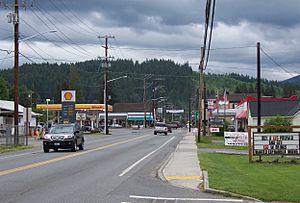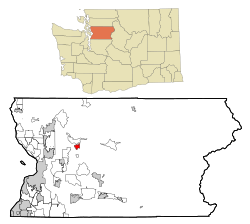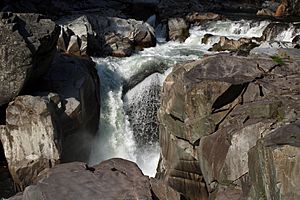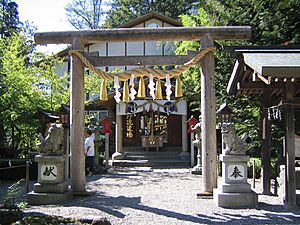Granite Falls, Washington facts for kids
Quick facts for kids
Granite Falls, Washington
|
||
|---|---|---|

Stanley Street (SR 92) in downtown Granite Falls
|
||
|
||

Location of Granite Falls, Washington
|
||
| Country | United States | |
| State | Washington | |
| County | Snohomish | |
| Government | ||
| • Type | Council–manager | |
| Area | ||
| • Total | 2.21 sq mi (5.72 km2) | |
| • Land | 2.19 sq mi (5.68 km2) | |
| • Water | 0.02 sq mi (0.05 km2) | |
| Elevation | 407 ft (124 m) | |
| Population
(2020)
|
||
| • Total | 4,450 | |
| • Estimate
(2022)
|
4,835 | |
| • Density | 2,013.57/sq mi (777.97/km2) | |
| Time zone | UTC-8 (Pacific (PST)) | |
| • Summer (DST) | UTC-7 (PDT) | |
| ZIP Code |
98252
|
|
| Area code | 360 | |
| FIPS code | 53-27995 | |
| GNIS feature ID | 1520218 | |
Granite Falls is a city in Snohomish County, Washington, United States. It's located between the Pilchuck and Stillaguamish rivers. This area is in the western foothills of the Cascade Range, northeast of Lake Stevens and Marysville. The city gets its name from a beautiful waterfall on the Stillaguamish River, just north of downtown. You can also reach this waterfall by driving on the Mountain Loop Highway. In 2020, about 4,450 people lived in Granite Falls.
Before American settlers arrived, the area where Granite Falls now stands was a portage (a place to carry boats over land) for local Coast Salish tribes. The first settlement was started in 1883. It grew quickly after gold and silver were found in the Monte Cristo mines to the east. These mines were connected to Granite Falls by the Everett and Monte Cristo Railway. Granite Falls was officially mapped out in 1891 and became an incorporated city on November 8, 1903.
Contents
History of Granite Falls
Early Inhabitants and Settlement
The Skykomish people, part of the Coast Salish tribes, lived in the area around the Pilchuck River and the Upper Stillaguamish River. They used the spot where Granite Falls is today as a portage. In the 1970s, archaeologists found several Skykomish sites between Granite Falls and Lochsloy, uncovering over 700 artifacts.
The first permanent European settler was Joseph Sous Enas from the Azores. He claimed land in 1883, south of the current city. Other settlers joined him, taking advantage of land cleared by a large wildfire called "the Big Burn." A school district started in 1886, first using an old cabin. A permanent school building was built in 1893. The discovery of gold and silver in the Cascades, especially near Monte Cristo, brought many miners and settlers to the Granite Falls area.
Growth and Incorporation
A general store and post office opened in 1890 where four homesteads met. This spot later became the center of the town, which was mapped in August 1891. The name "Granite Falls" was chosen for the settlement, replacing its earlier name, "Portage." The Everett and Monte Cristo Railway arrived in Granite Falls on October 16, 1892. It built a station for the town on its route between Monte Cristo and Everett, the county seat.
On November 8, 1903, the people of Granite Falls voted to become a city. It was officially incorporated on December 21, 1903. At that time, about 600 people lived there, and it had several lumber mills. Soon after, modern conveniences like electricity, sewers, sidewalks, telephones, and cars arrived. A power plant was also built at the falls.
Changes Over Time
By World War I, the busy mining towns of Monte Cristo and Silverton stopped shipping ore. The railroad, then owned by Northern Pacific, stopped running. Its tracks were removed in the early 1930s to make way for the Mountain Loop Highway.
Between the world wars, Granite Falls was mainly a lumber town. Logging companies cut down trees, sawmills made lumber, and shingle mills produced shingles. However, the Great Depression hit hard. By 1935, Granite Falls' population was half of what it was in 1925. Mills closed, and people left to find work. On April 26, 1933, a fire destroyed the Cascade Hotel downtown, but it was rebuilt in the same spot.
After World War II, things looked tough. But the opening of Miller Shingle in 1946 (which became the country's largest specialty lumber mill) brought new jobs. Construction booms in Snohomish and King counties also created jobs at the gravel pits around Granite Falls. The city later became a "bedroom community" for people who worked in Everett and Lake Stevens.
Hard times returned in 1986 when the United States Forest Service limited logging in old-growth forests to protect the northern spotted owl. In 1990, the spotted owl was declared an endangered species. This led to over a quarter of old-growth forests being protected from logging.
In the 21st century, Granite Falls has focused on attracting visitors to its natural beauty and outdoor activities along the Mountain Loop Highway. More housing developments have brought in families who commute to work in Everett, Seattle, and the Eastside. In 2001, the Tsubaki Grand Shrine of America was built in Granite Falls on a 17-acre (7 ha) plot of land.
A truck bypass was built around the north side of downtown Granite Falls in 2010. This helped reduce traffic from several quarries to the northeast. A new high school campus was built near the bypass, along with a new housing development in the late 2010s.
A project to improve downtown Granite Falls started in the 2000s. It included renovating buildings and a small city park. A new civic center is planned, with a city hall that opened in 2019, a public plaza, a community center, and a gym for the Boys & Girls Club. This gym will also serve as an emergency shelter. The city government also wants to promote Granite Falls as a place for outdoor recreation businesses.
Geography and Climate

Granite Falls is in Snohomish County, about 17 miles (27 km) east of Everett, the county seat. It's also about 45 miles (72 km) northeast of Seattle. The city sits on a flat area in the western foothills of the Cascade Range. To the north is the South Fork Stillaguamish River, and to the south is the Pilchuck River. Granite Falls is also the southern start of the Mountain Loop Highway. This is a scenic road that goes into the Cascades towards Darrington.
The city's borders are the Stillaguamish River to the north, Iron Mountain to the east, the Pilchuck River to the south, and 174th Avenue Northeast to the west. The city covers about 2.20 square miles (5.70 km2), with most of it being land.
The city is located where the South Fork of the Stillaguamish River leaves its narrow mountain valley. This area includes the famous Granite Falls waterfall. The falls have a 540-foot (160 m) fishway and a 280-foot (85 m) tunnel built in 1954. At the time, it was the longest fish tunnel in the world. Native tribes called the area where the city was founded "the portage." They used the flat land between the two rivers to carry their canoes. Iron Mountain, which is 1,240 feet (380 m) above sea level, is east of downtown and has a quarry.
What is the Climate Like?
Granite Falls has a mild climate. Temperatures don't change too much between highs and lows. Most of the rain falls between October and May. In the summer, temperatures can be up to 10 degrees warmer than in nearby Everett. This is because Granite Falls is a bit further inland. According to the Köppen Climate Classification system, Granite Falls has a marine west coast climate. This means it has cool, wet winters and warm, relatively dry summers.
Economy and Jobs
As of 2018, about 1,746 people in Granite Falls had jobs. The biggest job areas were education and health services, construction, manufacturing, and retail. Most people who live in Granite Falls travel to other places for work. For example, 19% commute to Everett, 11% to Seattle, and 5% to Marysville. Only about 5.2% of Granite Falls residents work within the city itself. Most workers (over 80%) drive to work alone. About 4% use public transportation or carpool.
In 2012, the city had 202 registered businesses with 849 total jobs. The largest employers were in education and services. Several big companies are in an industrial park in the northeast part of the city, near the Mountain Loop Highway. These include electrical manufacturer B.I.C. and aerospace manufacturer Cobalt Industries. Granite Falls is also near several rock and gravel quarries. These quarries caused a lot of truck traffic downtown until a bypass road opened in 2010.
Population and People
| Historical population | |||
|---|---|---|---|
| Census | Pop. | %± | |
| 1910 | 714 | — | |
| 1920 | 632 | −11.5% | |
| 1930 | 495 | −21.7% | |
| 1940 | 683 | 38.0% | |
| 1950 | 635 | −7.0% | |
| 1960 | 599 | −5.7% | |
| 1970 | 813 | 35.7% | |
| 1980 | 911 | 12.1% | |
| 1990 | 1,060 | 16.4% | |
| 2000 | 2,347 | 121.4% | |
| 2010 | 3,364 | 43.3% | |
| 2020 | 4,450 | 32.3% | |
| 2022 (est.) | 4,234 | 25.9% | |
| U.S. Decennial Census | |||
In 2020, the population of Granite Falls was 4,450 people. The city's population grew quickly in the 1990s and 2000s. This was due to new housing developments and the city expanding its borders.
What is the Population Like?
According to the 2010 census, there were 3,364 people living in Granite Falls. There were 1,222 households and 831 families. The city had about 1,543 people per square mile (596 per km2). Most residents (87.6%) were White. Other groups included African American (0.7%), Native American (1.2%), Asian (1.5%), and Pacific Islander (0.3%). About 7.5% of the population was Hispanic or Latino.
In terms of households, 42.5% had children under 18 living with them. About 49.5% were married couples. The average household had 2.75 people, and the average family had 3.33 people. The median age in the city was 34.4 years. About 29.4% of residents were under 18, and 8.4% were 65 or older. The population was almost evenly split between males (50.2%) and females (49.8%).
Culture and Community
Granite Falls hosts several yearly community events. The biggest is Railroad Days, held in early October. This festival started in 1965 and celebrates the city's history. It attracts about 5,000 visitors and includes a parade, a street fair, carnival rides, and tours.
The city's historical society opened its museum in October 2007. The museum has a project to digitize old photographs and newspaper records.
Arts and Entertainment
The Granite Falls area has been home to famous artists like Kenneth Callahan and Guy Anderson in the 1940s and 1950s. The city has several pieces of public art, including murals downtown and sculptures at local schools. One notable sculpture is a 12-foot (3.7 m) wood carving of Bigfoot made by a local expert in mysterious creatures. In 2000, Granite Falls put up sculptures of toilets to raise money for a public restroom during its annual Art in the Parks festival.
Parts of the 1977 movie Joyride and the 2018 movie Outside In were filmed in Granite Falls.
Parks and Recreation
Granite Falls is close to many outdoor recreation areas along the Mountain Loop Highway. These areas are in the Mount Baker–Snoqualmie National Forest and offer hiking, camping, and fishing. Popular spots on the Mountain Loop Highway include the ghost town of Monte Cristo and the Big Four Ice Caves. Other nearby recreation areas are Lake Bosworth and Lake Roesiger to the south. These lakes are regularly stocked with fish by the Washington Department of Fish and Wildlife.
The city government manages eight parks and nature preserves. These range from small neighborhood parks to larger recreational areas. The biggest is Frank Mason Park, which includes the 10-acre (4.0 ha) Lake Gardner and 32.4 acres (13.1 ha) of surrounding land. The park has a fishing pier, restrooms, picnic tables, and walking paths. The city and local school district also provide athletic facilities, a skate park, and a dog park for residents.
Local Media and Library
The first newspaper in Granite Falls, the Post, started publishing on July 23, 1903. It was later replaced by the Record in 1922 and then the Press. The Press later merged with a newspaper in Lake Stevens. Granite Falls is also covered by two regional daily newspapers: The Everett Herald and The Seattle Times.
Granite Falls has a public library that is part of the regional Sno-Isle Libraries system. The library joined this system in 1995. The 6,500-square-foot (600 m2) library building is east of downtown Granite Falls.
Religious Places
The Tsubaki Grand Shrine of America was located west of Granite Falls on 25 acres (10 ha) overlooking the Pilchuck River. This Shinto shrine was one of only a few in the United States. It opened in 2001 after moving from Stockton, California. The Tsubaki Grand Shrine was open to the public and hosted annual festivals and religious ceremonies. It also offered aikido lessons. The shrine's head priest, Lawrence Koichi Barrish, was one of the first non-Japanese people to become a Shinto priest. He retired in 2023, and the shrine closed.
The Holy Cross Catholic Church in downtown Granite Falls was built in 1903. It was a smaller church connected to St. Michael's Catholic Church until 2004. The church's members were split between Granite Falls and Lake Stevens until a new church was built in 2008. The old building was renovated for a Christian church that opened in 2015. The LDS Church started a local group in the 1990s and opened a chapel next to Granite Falls High School in 2009. Other religious places in the area include a Khmer Buddhist temple and an Evangelical Christian church.
Notable People from Granite Falls
- Kenneth Callahan, a painter and muralist
- Willo Davis Roberts, an author
- Mike Squires, a musician and songwriter
- Robert Sutherland, a state representative
Education in Granite Falls
Granite Falls has four public schools run by the Granite Falls School District. This district also serves nearby communities. In 2018, the school district had over 2,100 students and employed 107 teachers. Granite Falls has two elementary schools (Mountain Way and Monte Cristo), Granite Falls Middle School, Granite Falls High School, and Crossroads High School, which is an alternative school program. Andrea Peterson, a teacher at Monte Cristo Elementary School, was named the 2007 National Teacher of the Year.
The first schoolhouse in Granite Falls opened in 1893. A new building replaced it in 1910. A larger building for Granite Falls High School opened in 1938. The high school later moved to a new campus in January 2008. The high school's sports teams are called the Tigers. They compete in the North Sound Conference. A 1,700-seat football stadium opened at the new high school campus in 2018. It replaced the old stadium at the former high school, which had been turned into a middle school.
City Services and Transportation
How Do People Get Around?
Granite Falls is the end point of State Route 92. This road connects the area to State Route 9 in Lake Stevens. A 1.9-mile (3.1 km) bypass for trucks was finished around the north side of the city in 2010. This project cost $28.8 million. The scenic Mountain Loop Highway starts in Granite Falls and goes east into the Cascade Mountains. It then turns north to reach Darrington. About 55,000 tourists use this highway each year to access recreational areas in the Mount Baker–Snoqualmie National Forest.
Community Transit, the public transportation agency for the county, has one bus route that serves Granite Falls. This route connects the city to Lake Stevens and Everett Station. During busy times, it also offers service to the Boeing Everett Factory. The closest airport to Granite Falls is Paine Field in Everett.
Utilities and Services
Electric power in Granite Falls comes from the Snohomish County Public Utility District (PUD). This is a public utility that serves all of Snohomish County. The city government buys its tap water from the PUD. This water comes from the City of Everett system at Spada Lake and Lake Chaplain. Since 2012, the PUD has also supplied water to Granite Falls from groundwater wells near Lake Stevens. The city government also manages a sanitary sewage system. This system sends water to a treatment plant that releases treated water into the Pilchuck River.
Natural gas service for the city is provided by Puget Sound Energy. The city government works with Waste Management for trash, recycling, and yard waste collection. The Granite Falls area also has two recycling and disposal centers run by Snohomish County. Verizon and Comcast provide phone and internet services.
Healthcare Services
The closest general hospitals to Granite Falls are Providence Medical Center in Everett and Cascade Valley Hospital in Arlington. The city's medical clinic was part of the Cascade Valley system. This system became part of Skagit Regional Health in 2016.
See also
 In Spanish: Granite Falls (Washington) para niños
In Spanish: Granite Falls (Washington) para niños



